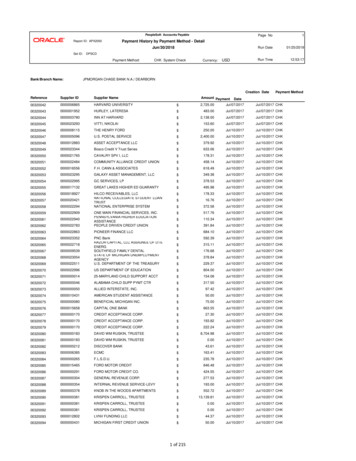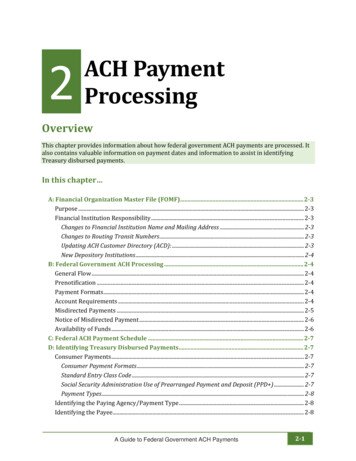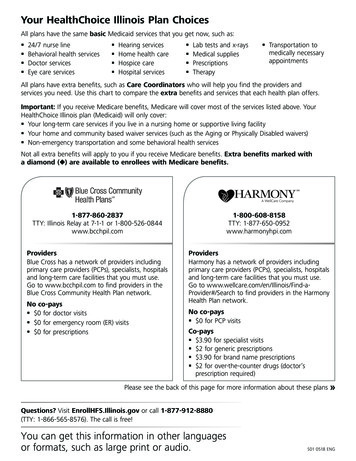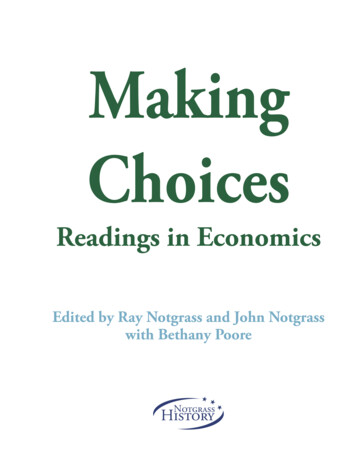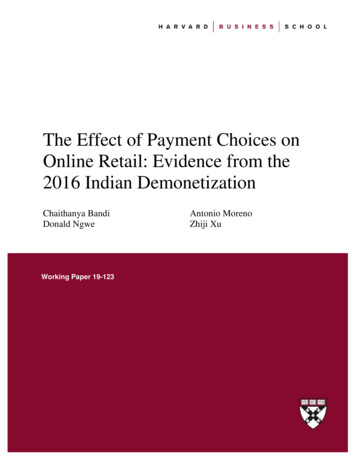
Transcription
The Effect of Payment Choices onOnline Retail: Evidence from the2016 Indian DemonetizationChaithanya BandiDonald NgweWorking Paper 19-123Antonio MorenoZhiji Xu
The Effect of Payment Choices onOnline Retail: Evidence from the 2016Indian DemonetizationChaithanya BandiAntonio MorenoNorthwestern UniversityHarvard Business SchoolDonald NgweZhiji XuHarvard Business SchoolNorthwestern UniversityWorking Paper 19-123Copyright 2019 by Chaithanya Bandi, Antonio Moreno, Donald Ngwe, and Zhiji XuWorking papers are in draft form. This working paper is distributed for purposes of comment and discussion only. It maynot be reproduced without permission of the copyright holder. Copies of working papers are available from the author.
The Effect of Payment Choices on Online Retail:Evidence from the 2016 Indian DemonetizationChaithanya BandiOperations Department, Kellogg School of Management, Northwestern University, Evanston, IL 60208c-bandi@kellogg.northwestern.eduAntonio MorenoTechnology and Operations Management Unit, Harvard Business School, Boston, MA 02163amoreno@hbs.eduDonald NgweMarketing Unit, Harvard Business School, Boston, MA 02163dngwe@hbs.eduZhiji XuOperations Department, Kellogg School of Management, Northwestern University, Evanston, IL 60208zhiji-xu@kellogg.northwestern.eduApril 5, 2019The Indian banknote demonetization in 2016 was one of the most significant international events of thatyear. Overnight, 86 percent of Indian currency in circulation was declared invalid unless exchanged for newbills. The sudden and unexpected demonetization constituted a large shock to the entire Indian economy.One effect of the ensuing cash shortage was a large and sustained increase in the adoption and usage ofdigital payments. We use detailed sales data consisting of more than two and a half million transactions froma leading Indian online retailer to empirically investigate the effects of payment digitization on the onlineretail industry. We take advantage of the demonetization as a source of exogenous variation that induceda subset of consumers to switch to digital payments from more commonly used cash-on-delivery payments.We show that consumers who switch to digital payments maintain their purchase frequency but spend moreand are less likely to return their purchases. Our findings show that firms in emerging markets may enjoygains from consumer demand in addition to operational gains resulting from payment digitization.Key words : cash on delivery; emerging markets; online retail; product returns; supply chain management1
Bandi, Moreno, Ngwe and Xu: The Effect of Payment Choice on Online RetailArticle submitted to Management Science; manuscript no. number to be assigned21.IntroductionThe Indian banknote demonetization was one of the most significant international events of 2016.Narendra Modi, the Indian prime minister, announced the demonetization in an unscheduled livetelevised address on November 8, 2016, declaring that the use of all 500- and 1,000-rupee banknotes would be invalid past midnight, and announcing the issuance of new 500- and 2,000-rupeebanknotes. Overnight, 86 percent of Indian currency in circulation ceased to be legal tender. Thestated aim of the demonetization was the elimination from the economy of illicit cash—funds connected to illegal activities that were held in cash to avoid government monitoring. The sudden andunexpected nature of the announcement and the weeks-long cash shortage that followed createdsignificant disruptions throughout the economy.The cash shortage had a particularly interesting impact on the online retail industry. As inseveral other major emerging markets, online shoppers in India typically have the option to payfor their purchases using digital payments (e.g., credit cards, debit cards, digital wallets) or toopt for cash-on-delivery (COD). Cash-on-delivery is a payment method in which customers payfor products with cash at the time of receipt. Its use predates e-commerce, but remains popularin the online retail industries of several large emerging markets, including those of China, Russia,Brazil, and India. As many as 60 percent of online transactions in India are conducted using COD(Nair 2013). Following the demonetization and the ensuing cash shortage, large numbers of Indiancustomers switched from using COD to using digital payments (Agarwal et al. 2018). This shockto payment choice presents an opportunity to study the effect of the mode of payment on outcomesfor online retailers in emerging markets.Online retail has been growing rapidly in emerging markets. The size of the online retail sectorin nine major developing countries—Brazil, Mexico, South Africa, Russia, Turkey, China, SaudiArabia, Indonesia, and India—could collectively increase from an annual turnover of USD 731billion in 2016 to USD 2.5 trillion by 2025, a 13 percent annual growth rate (Credit Suisse 2016).The main driver of this growth is the increase in internet access, particularly for lower-incomegroups in emerging markets. The rise in smartphone ownership also plays an important role in thisshift.The e-commerce industry in India has by itself been growing at an unprecedented rate. Its sizegrew from USD 14 billion in 2014 to USD 38.5 billion in 2016—a compound annual growth of40 percent (Foundation 2018). Online retail is the fastest-growing segment, having grown at anaverage annual rate of about 56 percent (PwC India 2015). The online retail market in India isestimated to be worth about USD 17.8 billion in gross merchandize value (GMV) as of 2017 and isestimated to have increased by 60 percent to USD 28 billion in 2018 (Foundation 2018). Flipkart,
Bandi, Moreno, Ngwe and Xu: The Effect of Payment Choice on Online RetailArticle submitted to Management Science; manuscript no. number to be assigned3considered the largest e-commerce venture in India, started in 2009 with a GMV of USD 10 million,and grew to USD 1 billion in 2014 and USD 4 billion in 2015 (Sharmal 2016). Snapdeal, anotherlarge Indian e-commerce company, grew by 500 percent between 2012 and 2013 and posted a GMVof USD 2.2 billion in May 2015 (Singh 2016).Cash-on-delivery is a popular payment choice for online retail in India for several reasons. First,the penetration of digital payments such as credit cards, debit cards, or mobile wallets is low. In2016, less than 25 million credit cards were active in the country (RBI 2017). In contrast, therewere 453 million credit cards in the US by the end of 2016 (Statista 2016). Second, even customerswith access to digital payments may be reluctant to employ them when buying online because of alack of trust or security concerns. This lack of trust by customers in online sellers further increasesthe attraction of the COD option, as payment is contingent on delivery and often inspection ofgoods.While COD offers some benefits to customers, it is a relatively costly payment method formerchants to process. A customer who opts for COD pays the delivery person at the time of receipt,who transfers the funds to a supervisor, who then remits the funds to the e-commerce firm. Therequired level of interaction between customers and delivery staff often results in multiple deliveryattempts for a single order. Time between payment and receipt by the firm of funds is typicallythree to five days, depending on the shipping location. In some extreme cases, the settlement periodcan last as long as three weeks.There is anecdotal evidence that COD purchases are associated with a higher instance of returns,as buyers are less committed to the purchase than if they had paid in advance (Das 2014). Inmost cases, customers can decline delivery at the door for free, requiring the delivery person toreturn the product upstream. As a result, there is little potential for regret costs for customers whomake impulse purchases. Returns can hurt firms not only by way of logistics costs of round-tripproduct delivery, but also through inventory costs of having unproductive inventory in the deliverypipeline and potential reordering from upstream firms in the supply chain. Both of these costs canbe amplified as transit time increases, especially in markets like India, with vast land areas andrelatively poor transport infrastructure. According to one Indian e-commerce company’s estimates,COD transactions add about three percent in additional costs, and the costs can increase by asmuch as 30 percent with returns (Nair 2013).The Indian demonetization of 2016 was thus of particular relevance for online retailers, whosaw a marked and sustained increase in the adoption of digital payments in the periods thereafter(Agarwal et al. 2018). Contributing to this shift was the prolonged cash shortage many Indiansexperienced following the demonetization. Related research has shown that most consumers who
Bandi, Moreno, Ngwe and Xu: The Effect of Payment Choice on Online RetailArticle submitted to Management Science; manuscript no. number to be assigned4adopted digital payments due to the demonetization tended to maintain their level of digitalpayment usage well beyond the cash shortage (Chodorow-Reich et al. 2018).In typical settings, a causal link between the mode of payment (e.g. cash versus card) and shopperbehavior is difficult to establish, as these decisions are possibly jointly determined; for instance,a customer may choose COD for smaller purchases but use her credit card for larger purchases.The shock from the demonetization provides rare exogenous variation in online shoppers’ paymentchoices that can be used to measure the effect of the mode of payment on purchase outcomes, suchas basket sizes and the frequency of product returns.We obtain data consisting of more than two and a half million transactions from a leading onlineapparel retailer in India. Our period of study covers a span of six weeks before and after thedemonetization. The panel structure of the data allows us to identify which customers are likelyto have switched payment methods because of the demonetization, and to measure the impact ofthe change on their behavior.We find that customers who switch to digital payments conduct as many transactions as thosewho continue using cash; however, they spend more on each transaction and are less likely to returntheir purchases. Our analysis of the data suggests that increased transaction sizes derive both froman increase in the number of items in each transaction as well an increase in the average price ofproducts sold. Furthermore, differences in both the prices of products sold and the rate of productreturn are broadly consistent across product categories.We conduct robustness checks of our analysis and find that our estimates are robust to alternativetreatment date specifications, group definitions, as well as the exclusion of time series information.Our analysis of alternative treatment date specifications suggests an interesting difference in howpurchase amounts and return rates vary with payment choice; our causal identification strategyappears to be less critical for return rates than it is for purchase amounts. Moreover, we find thatthe effect of payment choice on basket sizes and return rates are most pronounced for consumerswith the lowest pre-demonetization average order values.While digital payments in online retail are the norm in most advanced economies, online sellersin many emerging markets are in the early stages of a shift from cash-based payments to digitalpayments. Our findings show that these firms may enjoy gains from consumer demand on top ofoperational gains resulting from payment digitization.The remainder of the paper is organized as follows. Section 2 reviews the related literatureon payment choice, consumer behavior, and firm outcomes. Section 3 introduces the data andbackground information on the institutional setting. Section 4 outlines the estimation approach andpresents the results of our analysis. Section 5 presents results of robustness checks and additionalfindings concerning heterogeneous treatment effects. Section 6 concludes, points out limitations ofour study, and provides directions for future research.
Bandi, Moreno, Ngwe and Xu: The Effect of Payment Choice on Online RetailArticle submitted to Management Science; manuscript no. number to be assigned2.5Related literatureIn this section, we provide a review of related literature concerning modes of payment and onlineretail transactions. We touch on streams of research in operations management, consumer psychology, quantitative marketing, and macroeconomics. Within each stream, we cite the most closelyrelated papers, while acknowledging that the full extent of the related literature includes manymore studies.Prior research has put forth several psychological mechanisms through which a buyer’s modeof payment may influence her purchase decisions. Across several studies and hypothesized mechanisms, credit card payments have been shown to be associated with higher spending levels(Hirschman 1979; Soman 2001; Prelec and Simester 2001). These studies show that the effect persists regardless of whether credit cards are understood to relax consumers’ liquidity constraints.Even mere cues associated with credit cards have been found to enhance the probability, speed,and magnitude of spending (Feinberg 1986).One stream of research in particular identifies how the pain of payment may result in consumerspreferring to use payment modes such as credit cards, which are relatively decoupled from consumption, over cash, which is more tightly coupled to consumption (Prelec and Loewenstein 1998).This pain of payment has been found to make impulse purchases less likely; consumers were foundto be more likely to purchase unhealthy foods when using credit cards rather than cash (Thomaset al. 2010). Relatedly, cash payments have been found to result in strongler feelings of ownershipdue to an increase in the perceived investment in an object (Kamleitner and Erki 2013).Research on payment choice, while often agnostic to the institutional settings of transactions,has not specifically addressed the tradeoffs that may exist for customers choosing digital versusCOD payments when shopping online. However, work that examines the decoupling of paymentand consumption may be informative, in that digital payments are processed earlier than CODand are thus less coupled to consumption. Consumption, for instance, has been shown to be moreenjoyable for decoupled payments (Gourville and Soman 1998; Raghubir and Srivastava 2008)—leading perhaps to a lower probability of returned purchases in our setting.There also exists a stream of literature that examines customer preferences for payment choices,holding transaction characteristics constant. A consistent finding is that even credit and debitcard holders have a preference for cash usage, particularly for small-value transactions (Hancockand Humphrey 1997; Abdul-Muhmin 2010; Wakamori and Welte 2017; Cohen and Rysman 2013;Arango et al. 2015). These results seem broadly consistent in developed countries other than theUS, where carrying over credit card balances is more common (von Kalckreuth et al. 2013; Bagnallet al. 2014; Wang and Wolman 2016). Within the US, higher income has been seen to lead to
Bandi, Moreno, Ngwe and Xu: The Effect of Payment Choice on Online RetailArticle submitted to Management Science; manuscript no. number to be assigned6more credit card use (Carow and Staten 1999; Humphrey 2004; Klee 2008; Cohen and Rysman2013; Koulayev et al. 2016). Whereas much of the payment choice literature seeks to explain theprevalence of cash in developed economies with established card payment systems, research onpayment choice in emerging economies has found that mobile phones have enabled the proliferationof digital payments (Bech et al. 2018).There have been mixed results as to the benefit to sellers of more customers adopting digitalpayments. Some results suggest that merchant costs would decline if only cash transactions existed(Borzekowski and Kiser 2008; Briglevics and Shy 2014), whereas analyses of economy-wide welfarehave found or assumed that electronic payments are cost-saving for societies (Humphrey et al.2001; Bergman et al. 2007). The bulk of this research assumes demand and spending to be invariantto payment choice and focuses on the infrastructure and contractual costs of accepting digitalpayments. The literature has also remained largely silent on cash payments in online retail inemerging markets, within which processing costs may dwarf those for digital payments.In addition to seeking to establish a link between payment choice and purchase outcomes, ourresearch examines the effects of payment choices on the likelihood of product returns. Andersonet al. (2009) study the option value of returns for consumers using a structural modeling framework.Specific reasons for returns have also been explored in prior research, especially those relatingto poor match in taste and fit (e.g. Anderson et al. 2009, Altug and Aydinliyim 2016; Gallinoand Moreno 2018). Previous work has illustrated how free return policies can benefit customersatisfaction and lifetime value (Petersen and Kumar 2009; Bower and Maxham III 2012), whereasother work has examined how customers can be charged for returns in competitive settings (Wood2001; Shulman et al. 2011). To our knowledge, the impact of payment choice on the likelihood ofproduct return has not been studied in the existing literature.We contribute to these streams of research by examining the impact of payment choice in anunderstudied context: online retail in emerging markets. Our empirical setting is representativeof online sectors in many economies around the world, where the fast growth of e-commerce hasoutpaced the adoption of digital payments. The consequent predominance of cash payments foronline purchases in these markets presents an interesting empirical setting in which to examine therelationships between payment choice and purchase outcomes established in the related literature.In addition, the exogenous shock produced by the 2016 Indian demonetization provides a uniqueopportunity to measure the impact of payment choice on purchase outcomes in actual retail settings.In the following section, we describe the data we use for analysis and provide relevant details onthe empirical setting.
Bandi, Moreno, Ngwe and Xu: The Effect of Payment Choice on Online RetailArticle submitted to Management Science; manuscript no. number to be assigned3.7Background and dataWe obtain transaction data from a leading online fashion retailer in India. By the 2016 demonetization, the company had been in operation for over five years. The data span the period September29 to December 28, 2016, which is about six weeks before and after the demonetization, whichoccurred on November 8. We observe the date of each transaction, the stock-keeping unit (SKU)of each item sold, and a hashed customer ID that allows us to track individuals over time. We alsoobserve payment choice (COD or digital) and whether an item is returned or kept by the customer.As coded in the data, a return may represent either a refusal of the order at the time of deliveryor a later retrieval of the product by the firm.The data also include each SKU’s product category (e.g. t-shirt, casual shoes, etc.) as well asproduct-specific gender information (men, women, boys, girls, unisex). For each transaction, weobserve the following variables related to pricing: transacted price (Price) is the final selling priceof each product; merchant recommended price (MRP ) is the “original price” listed online; anddiscount (Discount) is the amount taken off the MRP.In total, the data set contains information on 4,528,324 items sold, 2,522,869 transactions,301,131 unique SKUs, and 1,485,795 customers. The average price of products sold is INR 914.35(about USD 13) with a standard deviation of INR 816.43 (about USD 11.5). A box plot of pricesi
the e ect of payment choice on basket sizes and return rates are most pronounced for consumers with the lowest pre-demonetization average order values. While digital payments in online retail are the norm in most advanced economies, online sellers in many emerging markets are in the early
